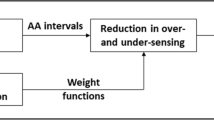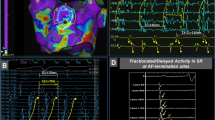Abstract
Background
Discrimination of local and far field potentials during sinus rhythm and atrial fibrillation (AF) is essential for successful pulmonary vein (PV) isolation. We sought to introduce an expert system for the classification of electrophysiologic PV signals.
Methods
For the expert system database, we analyzed ablation procedures of 50 patients with paroxysmal and persistent AF. Standard circumferential catheters and bipolar recordings were required. In a prospective trial, the expert system was compared with the performing electrophysiologists’ classifications of potentials during 15 procedures. A total of 1,343 recordings of local PV and far field signals were validated by the sudden disappearance of local potentials during ablation, the presence of dissociated PV activity, and pacing maneuvers. A fast Fourier transform was applied to the individual potentials. Analysis continued in the amplitude and phase representation.
Results
Four parameters significant (p < 0.001) for classification were identified and entered a logistic regression model. Overall sensitivity and specificity of the model was 87% with minor, nonsignificant variations for individual PVs and different underlying rhythms. Concordance with ad hoc electrophysiologists’ classification of local potentials was 70%, which increased during post hoc analysis to 86% since classification of 14% of the potentials had to be revised. For these potentials, the expert system correctly predicted their local origin in 86%.
Conclusion
An expert system for the evaluation of electrophysiologic signals based on morphology analysis using the Fourier transform is feasible. The ease of use and online availability facilitate a widespread use for AF ablation procedures.






Similar content being viewed by others
References
Haissaguerre, M., Jais, P., Shah, D. C., Takahashi, A., Hocini, M., Quiniou, G., et al. (1998). Spontaneous initiation of atrial fibrillation by ectopic beats originating in the pulmonary veins. The New England Journal of Medicine, 339, 659–666.
Cappato, R., Calkins, H., Chen, S. A., Davies, W., Iesaka, Y., Kalman, J., et al. (2005). Worldwide survey on the methods, efficacy, and safety of catheter ablation for human atrial fibrillation. Circulation, 111, 1100–1105.
Gerstenfeld, E. P., Callans, D., Dixit, S., Lin, D., Cooper, J., Russo, A. M., et al. (2007). Characteristics of patients undergoing atrial fibrillation ablation: trends over a seven-year period 1999–2005. Journal of Cardiovascular Electrophysiology, 18, 23–28.
Haissaguerre, M., Sanders, P., Hocini, M., Takahashi, Y., Rotter, M., Sacher, F., et al. (2005). Catheter ablation of long-lasting persistent atrial fibrillation: critical structures for termination. Journal of Cardiovascular Electrophysiology, 16, 1125–1137.
Ouyang, F., Bansch, D., Ernst, S., Schaumann, A., Hachiya, H., Chen, M., et al. (2004). Complete isolation of left atrium surrounding the pulmonary veins: new insights from the double-Lasso technique in paroxysmal atrial fibrillation. Circulation, 110, 2090–2096.
Oral, H., Chugh, A., Scharf, C., Hall, B., Cheung, P., Veerareddy, S., et al. (2004). Pulmonary vein isolation for vagotonic, adrenergic, and random episodes of paroxysmal atrial fibrillation. Journal of Cardiovascular Electrophysiology, 15, 402–406.
Hocini, M., Shah, D. C., Jais, P., Haissaguerre, M., Peng, J. T., Yamane, T., et al. (2000). Concealed left pulmonary vein potentials unmasked by left atrial stimulation. Pacing and Clinical Electrophysiology, 23, 1832–1835.
Iwasa, A., Storey, J. A., Tashakkor, B., & Feld, G. K. (2003). Identification of pulmonary vein potentials by differential site atrial pacing in patients with paroxysmal atrial fibrillation: enhanced detection by pulmonary vein pacing. Journal of Cardiovascular Electrophysiology, 14, 1311–1318.
Tada, H., Oral, H., Ozaydin, M., Greenstein, R., Pelosi, F., Jr., Knight, B. P., et al. (2002). Response of pulmonary vein potentials to premature stimulation. Journal of Cardiovascular Electrophysiology, 13, 33–37.
Shah, D., Haissaguerre, M., Jais, P., Hocini, M., Yamane, T., Macle, L., et al. (2002). Left atrial appendage activity masquerading as pulmonary vein potentials. Circulation, 105, 2821–2825.
Patel, N., Kay, G. N., Sanchez, J., Ideker, R. E., & Smith, W. M. (2003). Discrimination of left atrial and pulmonary vein potentials in patients with paroxysmal atrial fibrillation. Journal of Cardiovascular Electrophysiology, 14, 698–704.
Haissaguerre, M., Jais, P., Shah, D. C., Garrigue, S., Takahashi, A., Lavergne, T., et al. (2000). Electrophysiological end point for catheter ablation of atrial fibrillation initiated from multiple pulmonary venous foci. Circulation, 101, 1409–1417.
Tada, H., Oral, H., Greenstein, R., Pelosi, F., Jr., Knight, B. P., Strickberger, S. A., et al. (2002). Differentiation of atrial and pulmonary vein potentials recorded circumferentially within pulmonary veins. Journal of Cardiovascular Electrophysiology, 13, 118–123.
Yamane, T., Shah, D. C., Jais, P., Hocini, M. M., Deisenhofer, I., Choi, K. J., et al. (2002). Electrogram polarity reversal as an additional indicator of breakthroughs from the left atrium to the pulmonary veins. Journal of the American College of Cardiology, 39, 1337–1344.
Ho, S. Y., Sanchez-Quintana, D., Cabrera, J. A., & Anderson, R. H. (1999). Anatomy of the left atrium: implications for radiofrequency ablation of atrial fibrillation. Journal of Cardiovascular Electrophysiology, 10, 1525–1533.
Nakagawa, H., Aoyama, H., Beckman, K. J., Po, S. S., Wu, R., Lockwood, D., et al. (2004). Relation between pulmonary vein firing and extent of left atrial-pulmonary vein connection in patients with atrial fibrillation. Circulation, 109, 1523–1529.
Takahashi, Y., O'Neill, M. D., Jonsson, A., Sanders, P., Sacher, F., Hocini, M., et al. (2006). How to interpret and identify pulmonary vein recordings with the lasso catheter. Heart Rhythm, 3, 748–750.
Financial disclosures
Dr. Hanno Klemm reports having received honoraria and travel grants from Bard Electrophysiology. Dr. Heitzer, Dr. Ruprecht, Dr. Johnsen, Dr. Meinertz, and Dr. Ventura report to conflicts of interest.
Author information
Authors and Affiliations
Corresponding author
Additional information
All authors had full control of all primary data and agree to allow the journal to review the data if requested.
Rights and permissions
About this article
Cite this article
Klemm, H.U., Heitzer, T., Ruprecht, U. et al. Introduction of an expert system for the discrimination of local pulmonary vein and atrial far field signals. J Interv Card Electrophysiol 29, 83–91 (2010). https://doi.org/10.1007/s10840-010-9508-2
Received:
Accepted:
Published:
Issue Date:
DOI: https://doi.org/10.1007/s10840-010-9508-2




